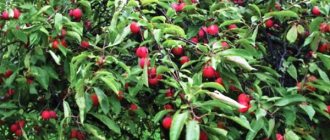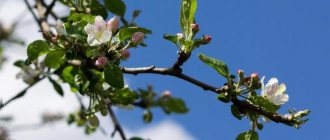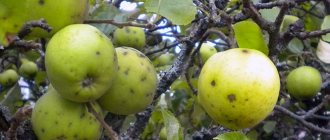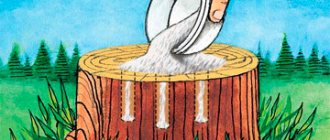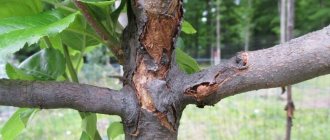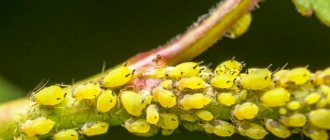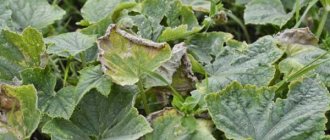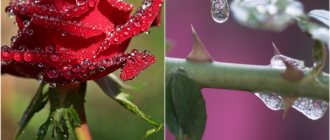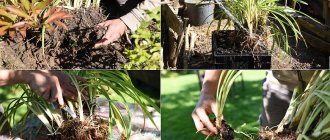Causes
Experienced summer residents know that the complete absence of a harvest can be explained by a limited number of reasons, so they can easily answer beginners’ questions about why an apple tree does not bear fruit and what to do if it does not bear fruit for a long time.
The reasons for partial or periodic lack of harvest can be recognized by additional signs.
Complete absence of fruiting
If the apple tree does not begin to bear fruit on time, this is the consequence of incorrect agricultural technology , the vagaries of the weather, or an error in calculations.
Incorrect landing
When planting, it is important to consider all factors that can affect the yield and development of the apple tree.
These include:
- Poor soil quality;
- Proximity of groundwater;
- Strong deepening of the root collar;
- Trunk deformation: tilting or curvature;
- Wrong choice of location: northern, windy slope.
As a result of such errors during planting, the young tree begins to bear fruit much later. The time of fruit appearance may be delayed by one to three years.
What to do when the apple tree does not bear fruit, what to do? We need to work to eliminate the causes of this phenomenon. Let's look at them below.
Young age
Before you start looking for the reasons why young apple trees do not bear fruit, you should check your calculations. Perhaps the gardener made a mistake and is waiting for fruiting too early.
A young tree should grow, become stronger, develop a strong root system and a branched crown.
When purchasing, find out the timing of the start of fruiting for this variety.
When purchasing a seedling, you need to find out how long it will take. On average, fruiting occurs in 4-5 years.
It is possible that the planted variety begins to bear fruit in 7-8 years.
There are apple trees that produce a harvest only for 20-25 years. Good to know! The age of fruiting depends on the selected rootstock.
| Type of rootstock | Fruiting age |
| Tall | 6-10 years |
| Medium height | 3-5 years |
| Semi-dwarf | 2-4 years |
| Dwarf | 2-3 years |
| Columnar | 2-3 years |
These indicators are average; fruiting is also influenced by the variety that is grafted onto the rootstock .
If an apple tree on a seed rootstock begins to bear fruit in 5-6 years, the same variety grafted onto a dwarf one will begin to produce a harvest 1-2 years earlier.
A long absence of fruiting is quite possible when planting purchased seedlings:
- The apple tree could have been sold at a younger age than the buyer was told.
- Re-grading is also possible.
- The most unpleasant option is if you come across an ungrafted seedling or wild game . In the first case, you will have to wait for a very long time, and in the second, apart from the long wait, the buyer will not be able to get quality apples. They will grow small and tasteless.
Important! Typically, winter varieties begin to bear fruit later.
Oversaturation with microelements
A complete lack of fruiting, both in young and adult apple trees, can occur due to the gardener’s excessive zeal.
Perhaps, in an effort to better feed the apple tree, the nitrogen content in the soil was exceeded .
With an excess of this microelement, the tree grows and develops well, blooms with foliage, but does not bear fruit. People say that the plant is “overfed” .
Damage to flower buds
The effects of frost can affect both young and mature trees.
Winter-hardy varieties can damage the buds when late spring frosts occur. If abnormal cold occurs during flowering, there will be no fruit this season.
Varieties with poor winter hardiness may suffer frostbite during winter frosts. This will be noticeable by the condition of the tree.
In this case, it will not only not bear fruit, but growth and development will also be at risk.
Flower buds can be damaged by pests .
Poor pollination
There are not very many apple trees that are self-fertile The most common varieties are partially self-pollinating.
Therefore, it is necessary to plant several trees, selecting them in pairs or triplets according to flowering dates.
IMPORTANT! Varieties that ripen at the same time may have different flowering periods.
Irregular fruiting
Increased yield
High yield.
The frequency or cyclicity of fruiting directly depends on the yield of the tree. You can understand what to do if the apple tree does not bear fruit if you analyze how many apples were collected the year before problems arose.
As a result, it will become clear that before it stopped bearing fruit, the apple tree produced too rich a harvest. The cyclicity is especially noticeable on mature trees.
Apple trees that are more than five years old require a longer recovery than young specimens. Therefore, with age, if nothing is done, rest periods will increase.
The intervals between fruiting can reach seven years, this explains why the apple tree does not bear fruit for 5 years.
Varietal feature
Mature apple trees of the Melba and White Naliv are characterized by the fact that they do not bear fruit every year without additional manipulations on the part of the gardener.
If you plant one apple tree of these varieties on a plot, the likelihood of it bearing fruit will be very low. Both varieties have poor self-pollination.
There are varieties, for example, Medunitsa , which bear fruit annually for the first ten years, and then cyclicality appears and the crop ripens every second year.
Spartan variety not only exhibits periodicity with age, but is also subject to severe fruit crushing.
The onset of fruiting in apple trees with small fruits occurs at different times.
If Chinese plants often begin to produce crops in 3-4 years, then ranetki can be waited for 8-12 years.
Problems with fruiting of these apple trees are often associated with cold winters, when plant buds may freeze. If there are no abnormal frosts, small-fruited apple trees bear fruit annually.
Frosty winters and improper winter shelter leave creeping apple trees . In addition to frostbite , such trees can become rotten .
If, during formation, several branches are simultaneously secured with one staple, the harvest on these branches will also be at risk.
Formation is important for dwarf apple trees . It often happens that they stop bearing fruit. In these species, fruiting is greatly affected by excessive crown density .
Pyramidal (columnar) apple trees also have their own . Many beginning gardeners cannot get a harvest from them.
These species require constant careful care , as well as shelter for the winter in areas with cold climates.
Attention! Often, the frequency of fruiting is determined by the genetic characteristics of the variety.
Improper pruning and crown formation
Errors in pruning and injury to branches may be the reason why an apple tree does not bear fruit.
This often happens from simultaneous pruning of a large number of branches . The apple tree spends all its energy on the active growth of vegetative mass, instead of forming flower buds.
Novice gardeners may mistake the important organs of the apple tree - the ringlets and spears - for deformed shoots and break them off.
Ringlets and spears of an apple tree.
These branches are responsible for fruiting, just like fruit twigs. The larger and more diverse the fruit shoots , the greater the likelihood of annual fruiting.
If the branches grow almost vertically , they will bear fruit late. A thickened has a bad effect on productivity .
Leaves in such a crown receive insufficient sunlight and are poorly ventilated. The apple tree responds to this with a meager harvest or its absence.
Other Possible Factors
Branch growth direction
The growth of branches in the vertical direction is one of the reasons for the lack of harvest, because inflorescences and fruits are formed only on horizontally growing fruit-bearing shoots.
This situation can be corrected by hanging a load on the branches. You can expect the first harvests after this procedure in 2-3 years.
Watering
Trees rarely require watering, but during a prolonged hot season it becomes necessary because... Lack of sufficient amounts of water can also cause delayed flowering and fruiting of the apple tree.
Young seedlings under 2 years of age are watered with 20-30 liters, adults 3-5 years old with 50-80 liters, old seedlings over 5 years with 100 liters per tree.
Return frosts
The so-called return frosts, which often occur in the spring, are another non-standard reason. A sharp drop in temperature during active bud bloom leads to their damage.
How to overcome fruiting problems?
If the reason for the lack of fruiting is improper planting, you can do it in two ways.
Correct the situation on the spot and wait
- Groundwater is drained using drainage ditches.
- The composition of the soil is corrected by annual fertilizing .
- The deformation of the trunk can be changed by tying the tree to a support.
- Concerning deep landing, then you need to decide whether it is intentional or done out of ignorance. Experienced gardeners deepen apple trees when planting:
- First, it allows the grafted variety to grow its own roots in addition to those of the scion.
- Secondly, with such planting it is possible to protect the grafting of a low-winter-hardy variety from frost.
Such trees begin to bear fruit later, but they grow stronger .
The gardener does not risk losing a valuable variety.
Replant an apple tree
Find the right place and meet all the necessary conditions.
Attention! According to the rules of agricultural technology, when planting, the graft should rise 5-7 cm above the ground. If you adhere to this rule, the planted apple trees will produce a harvest within the stated time frame.
If the apple tree was initially planted on the north side, where the winds constantly blow, then replanting is indispensable to obtain a harvest.
Deep planting of apple trees
If in the south of our country there are methods of deepening seedlings when planting, then in our country, with our excessive moisture, this is simply unacceptable. I have seen several times how visitors from Central Asia authoritatively convinced our summer residents to plant bushes and trees deep. Masters have been found! Ostrich teaches penguins to survive in ice...
Often, a summer resident, without meaning to, plants in such a way that his seedlings, after watering, end up being pulled into a loose planting hole.
In the conditions of the Middle Zone, it is necessary to plant all trees only at some elevation, at least 10–20 cm in height, so that the root collar is above the general soil level. The vagaries of nature will not keep you waiting: once every 10–15 years, or even more often, the plants become very wet due to prolonged autumn precipitation, and your trees will be safe.
Creating conditions for pollination
A tree that is not happy with its harvest should choose a pollinator variety . It will be an apple tree that blooms at the same time.
If it is not possible to plant a tree , you can graft a sprig of a pollinator variety into the crown of a problem apple tree.
Alternatively , flowering branches of an additional variety can be fixed in the crown of the apple tree, having previously taken care to moisten their cuts.
Honey plants should be planted in the garden to attract insects.
Pest treatments
In order to get rid of flower beetles, pest control treatments are necessary .
The first of them is carried out in early spring, even before the buds wake up.
Then the apple orchard is sprayed before and after flowering, at intervals of two weeks.
copper and sulfur can be used :
- Bordeaux mixture;
- Home;
- Cuprostat;
- Colloidal sulfur;
- Kuprikol.
Or you can choose a systemic fungicide that will act for a long time:
- Aktara;
- Aktellik;
- Topaz;
- Raek;
- Inta-Vir;
- Speed, etc.
Flower buds are affected
Flower buds can be damaged due to frost and flower beetle activity. If we talk about the impact of sub-zero temperatures, preserving kidneys is not easy. When a tree does not bloom, but leaves bloom, this indicates that it has responded to unexpected thaws in winter.
When the reproductive buds began to wake up, they died, and after the winter temperature stabilized, the leaf buds, which are more resistant to winter temperature fluctuations, survived. It also happens that the flower buds of an apple tree are destroyed under the influence of age-related frosts when they first bloom, but after the onset of sub-zero temperatures the flowers are damaged and no harvest can be expected. You can try to make an effort and save the flowers, but you can’t always hope for a favorable outcome.
Related article:
Proper care of apple trees in the fall. Detailed Guide
Smoke fires will help to increase the air temperature in the garden when the trees are blooming and frost has overtaken them. They need to be lit along the entire perimeter of the site. Then it is necessary to build huge piles of non-dry straw or similar material, which, when set on fire, does not burn, but smolders. The fire will have to be constantly maintained. So, the garden will be filled with smoke all the time.
This method of increasing the temperature is quite effective, but it requires serious physical effort - you will have to be in the garden constantly. Such manipulations should be performed when there is no wind, otherwise smoke will be blown out of the garden and this will not bring the desired result.
You can also finely spray the tree with small drops of water from a hose to which a special nozzle is attached. So, drops of water will freeze on the flowers and begin to give off heat to them. You can protect the tree from flower beetles, which eat away the contents of the flower, using insecticides. You need to resort to the first treatment before the buds open, the second and subsequent ones after they bloom.
Related article:
How to plant columnar apple trees correctly
At the initial stage, you can use more gentle medications. A 2-fold Bordeaux mixture or 3-fold copper sulfate will do. Hunting belts and pheromone traps can be placed on tree trunks. If these methods do not give effect, you can use insecticides with an aggressive composition. Such products must be used according to the instructions.
Apple orchard
Trimming and rationing
By correct pruning and normalizing the number of ovaries, you can force the apple tree to produce a harvest every year.
Pruning Principles for a Bountiful Harvest
Trimming.
Any variety of apple tree needs sufficient sunlight and space . Therefore, from the moment of planting, they need the correct formation of the crown.
The gardener’s task is not just to trim the tree, but to make sure that every leaf has access to light and is well ventilated .
In order to quickly get a harvest for tall apple trees, starting from the age of 5, their are cut off . The desired tree height is about 4 meters.
Advice! You cannot cut off a large number of old branches . The tree will begin to actively grow green mass to the detriment of fruiting.
If the apple tree needs drastic pruning for rejuvenation, the work should be spread out over two to three years.
Branches that grow vertically are either removed during pruning so that the apple tree does not waste its energy on them, or they should be given a horizontal position.
To achieve earlier fruiting , ringing is used.
To do this, at the growth point, 1 cm of bark around the circumference is removed from the branch. The wound is covered with garden putty or wrapped with film.
This technique allows you to redirect the tree's forces to the formation of flower buds .
For the same purpose, fruit belts made of tin tied with wire are used. The advantage of the belt is that it can be removed at any time, without damaging the tree.
Rationing
By rationing you can achieve annual fruiting of almost any variety. Even one in which the periodicity of the harvest is genetically determined.
The method involves removing excess flower buds . No more than 10 flowers are left on each branch.
There is only one drawback to rationing . It is impossible to obtain large yields.
You should decide for yourself what to choose: annual moderate fruiting of the apple orchard or abundant fruiting once every two to three years.
Prevention measures
A healthy garden is the key to good harvests. Therefore, competent gardeners must carry out disease prevention. To do this, the season ends with the following events:
- Removing leaves and fallen fruits from under trees and tree trunks. Spores of harmful fungi and insect larvae overwinter in plant debris, especially rotting fruits.
- Sanitary pruning: removal of dried and injured branches, formation of the crown with cutting out shoots that thicken, duplicate each other and grow inside the crown. The sections are coated with varnish.
- Cleaning infected areas of the trunk and shoots, treating with fungicides.
- Whitewashing the trunk.
- Protection of young tree trunks from rodents. The trunks are wrapped with nylon, fiberglass, plastic mesh and other available materials.
At the beginning of the season, when the snow has melted, the apple trees are inspected to cut out branches broken by snow, clean and treat frost marks on the bark.
Unconventional methods
Methods tested by gardeners, but unproven by science, include:
Landing according to lunar rhythms
An apple tree should be planted two to three days before the new moon .
For some reason, the growth of the tree is limited, and the apple tree begins to bear fruit ahead of schedule.
Intimidation
A tool for intimidation.
Experienced gardeners advise strongly “scaring” the tree. To do this, they approach the apple tree with an ax and threaten to cut it down.
The method is absolutely not scientific , but its successful use has been noticed in Russia for several decades.
